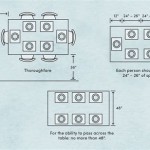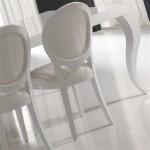How High Should A Chandelier Hang Over A Table?
Determining the optimal height for a chandelier above a table is a crucial aspect of interior design, affecting both the aesthetics and functionality of a space. A chandelier hung at the wrong height can obstruct views, cast unflattering shadows, or simply appear disproportionate to the surrounding environment. Achieving the correct hanging height ensures that the chandelier serves its purpose as both a light source and a decorative focal point.
Factors influencing the ideal height include the size of the chandelier, the dimensions of the table, the ceiling height of the room, and the overall style of the space. A carefully considered approach, taking these elements into account, will result in a harmonious and visually pleasing arrangement.
Standard Guidelines for Chandelier Height Above a Dining Table
General guidelines provide a starting point for determining the appropriate chandelier height. A common recommendation is to hang the bottom of the chandelier approximately 30 to 36 inches above the table surface. This range is generally considered safe and comfortable, allowing for unobstructed views and preventing accidental contact with the chandelier. These measurements, however, are not universally applicable and should be adjusted based on specific circumstances.
For instance, in rooms with higher ceilings, the chandelier can be hung slightly higher without compromising visibility. Conversely, in rooms with lower ceilings, it might be necessary to reduce the hanging height to maintain a sense of proportion and prevent the chandelier from feeling overwhelming. This adjustment requires careful consideration to ensure the chandelier remains visually appealing and functional.
The size of the chandelier itself also plays a significant role. Larger, more substantial chandeliers often require a slightly higher placement to avoid dominating the table and the surrounding area. Smaller, more delicate chandeliers may benefit from a slightly lower placement to create a more intimate and inviting atmosphere. The key is to achieve a balance between the size of the fixture and the height at which it is hung.
Furthermore, the style of the chandelier can influence the perceived optimal height. A chandelier with long, cascading elements may need to be hung higher to allow these elements to hang freely without interfering with the table surface. Conversely, a more compact, minimalist chandelier may be suitable for a lower hanging height.
Considering Ceiling Height and Room Dimensions
Ceiling height is a primary factor in determining chandelier placement. The standard 30-36 inch rule is typically applicable for ceilings of standard height, generally around 8 feet. However, as ceiling height increases, the chandelier can be hung proportionally higher to maintain visual balance within the room.
For ceilings exceeding 8 feet, add approximately 3 inches of height for each additional foot of ceiling height. For example, in a room with a 10-foot ceiling, adding 6 inches to the standard 30-36 inches results in a recommended hanging height of 36-42 inches above the table. This adjustment ensures that the chandelier remains a prominent feature without feeling dwarfed by the increased ceiling height.
Room dimensions also play a crucial role in achieving visual harmony. In larger rooms, a larger chandelier is typically required to fill the space adequately. A larger chandelier necessitates a higher hanging height to prevent it from overwhelming the table and the surrounding area.
The overall aesthetic of the room should also be taken into account. In more formal dining rooms, a higher chandelier placement can contribute to a sense of grandeur and elegance. In more casual dining areas, a slightly lower placement can create a more relaxed and intimate atmosphere. The goal is to ensure that the chandelier complements the overall design style of the room.
Adjusting for Chandelier Style and Table Size
The style of the chandelier is a significant determinant of the appropriate hanging height. Chandeliers with intricate designs or multiple tiers often benefit from a higher placement to allow the details to be fully appreciated. This higher placement also prevents the chandelier from feeling cluttered or overwhelming.
In contrast, simpler, more minimalist chandeliers can often be hung slightly lower without compromising visual appeal. These types of fixtures are designed to be unobtrusive and to blend seamlessly with the surrounding décor. A lower placement can enhance their subtle elegance and create a more intimate atmosphere.
The size and shape of the table also influence the optimal chandelier height. For smaller, round tables, a smaller chandelier hung at a slightly lower height can create a cozy and inviting ambiance. For larger, rectangular tables, a larger chandelier hung at a higher height is often more appropriate to provide adequate illumination and visual balance.
The shape of the chandelier should also complement the shape of the table. A round chandelier is typically well-suited for a round table, while a rectangular or oval chandelier is often a better choice for a rectangular or oval table. This coordination of shapes enhances the overall visual harmony of the space.
When selecting a chandelier, consider the scale of the fixture in relation to the table. As a general rule, the diameter or width of the chandelier should be approximately one-half to two-thirds the width of the table. This proportion ensures that the chandelier is neither too large nor too small for the space.
Ultimately, determining the optimal chandelier height is a balancing act that requires careful consideration of various factors. By taking into account ceiling height, room dimensions, chandelier style, and table size, it is possible to achieve a harmonious and visually pleasing arrangement that enhances the overall aesthetic of the dining area.
The material of the chandelier can also influence the perceived optimal height. A chandelier made of heavy, dark materials may appear more imposing and require a higher placement to prevent it from feeling overwhelming. Conversely, a chandelier made of light, airy materials may be suitable for a lower hanging height.
The lighting output of the chandelier should also be considered. A chandelier with a high lighting output may need to be hung higher to prevent glare. Conversely, a chandelier with a low lighting output may benefit from a lower placement to provide adequate illumination to the table surface.
In addition to the height above the table, it's also important to consider the distance between the chandelier and the walls. As a general rule, the chandelier should be centered over the table and should be at least 2 to 3 feet away from the walls. This spacing ensures that the chandelier does not feel cramped or confined and that it is able to illuminate the entire dining area effectively.
Finally, it is always recommended to test the hanging height before permanently installing the chandelier. This can be done by temporarily suspending the chandelier at different heights and observing how it looks and feels in the space. This allows for fine-tuning the placement to achieve the perfect balance of aesthetics and functionality.

How High Should My Light Fixture Hang Above Dining Table Schoolhouse

How To Hang A Chandelier At The Perfect Height Over Dining Table Mod Lighting

Dining Room Chandelier Size Guide Delmarfans Com

Height From Dining Table To Chandelier Sales

How High Should You Hang Your Dining Room Chandelier Arched Manor

Ace Wrought Iron Chandelier Size And Height Guide

Wolberg Lighting Design And Electrical Supply How To Properly Hang A Chandelie

How High Should You Hang A Chandelier Over Table Mcqueens Interiors

The Correct Height For Dining Room Lighting Lightbox

How High To Hang A Chandelier Above Dining Table Lightopia








